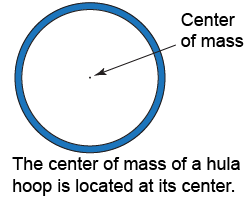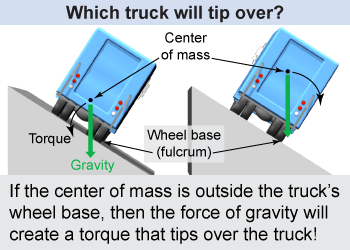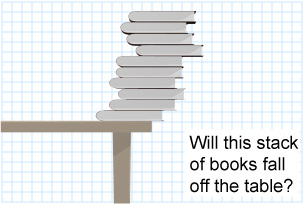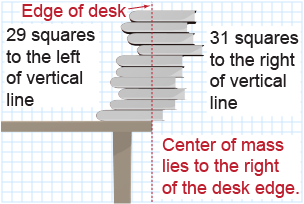|
 The center of mass is the average position of all the mass contained in an object (see page 135). That means that there is an equal quantity of mass on either side of any plane splitting an object through the center of mass regardless of which plane is chosen. The center of mass is sometimes called the “center of gravity” because it represents the average point at which the force of gravity acts on an object.
The center of mass is the average position of all the mass contained in an object (see page 135). That means that there is an equal quantity of mass on either side of any plane splitting an object through the center of mass regardless of which plane is chosen. The center of mass is sometimes called the “center of gravity” because it represents the average point at which the force of gravity acts on an object. 
|
When an object is rotating and translating at the same time we often separate the motions into two parts using the center of mass as a reference. - The linear motion is the translation of the center of mass. The linear momentum is the object’s mass times the velocity of the center of mass.
- The rotational motion is about the center of mass. The angular momentum is defined relative to an axis passing through the center of mass.

|
 For geometrical objects, such as a solid sphere or cube, the center of mass is located at the object’s geometrical center. While some irregularly shaped objects may still have their center of mass located inside them, others can have the center of mass outside their body. Where is the center of mass of a hula hoop located? The answer is at its center, even though no mass is located there!
For geometrical objects, such as a solid sphere or cube, the center of mass is located at the object’s geometrical center. While some irregularly shaped objects may still have their center of mass located inside them, others can have the center of mass outside their body. Where is the center of mass of a hula hoop located? The answer is at its center, even though no mass is located there! 
|
The beautiful feature of the center of mass is that it allows us to simplify a complex situation. The force of gravity can be assumed to act on the center of mass, as if all the mass of the object were concentrated at that point. 
 |
The term point mass often appears in physics textbooks. What is a point mass? It is a hypothetical particle that is infinitely small—yet it can still have mass. In other words, it has the mass of an ordinary object but the size of a “point”! Why would we want to think about such a tiny object? In Newtonian mechanics, the force of gravity acts on a body as if all of its mass were concentrated at a single point—the center of mass. Conceptually, we can replace any object with a single point mass located at its center of mass. 
|
 The center of mass represents the balance point: If you placed the object on a pencil tip located directly below the center of mass, the forces should balance! Imagine a truck driving horizontally along a steep slope. Will it tip over? The force of gravity acts on the center of mass of the truck; gravity creates a torque about the truck’s wheelbase. If the truck’s center of mass is located vertically above or inside the wheelbase, the torque will act to keep the truck upright. But if the truck’s center of mass is located beyond the wheelbase, the torque exerted by gravity will cause it to tip over. This is why the heaviest cargo should be loaded near the bottom of the truck!
The center of mass represents the balance point: If you placed the object on a pencil tip located directly below the center of mass, the forces should balance! Imagine a truck driving horizontally along a steep slope. Will it tip over? The force of gravity acts on the center of mass of the truck; gravity creates a torque about the truck’s wheelbase. If the truck’s center of mass is located vertically above or inside the wheelbase, the torque will act to keep the truck upright. But if the truck’s center of mass is located beyond the wheelbase, the torque exerted by gravity will cause it to tip over. This is why the heaviest cargo should be loaded near the bottom of the truck! 
|
 A student stacked 10 textbooks along the edge of a desk, as shown in the figure at left. If all the textbooks are identical and have uniform density, will the stack fall off the edge of the desk?
A student stacked 10 textbooks along the edge of a desk, as shown in the figure at left. If all the textbooks are identical and have uniform density, will the stack fall off the edge of the desk?
 |
 Yes, it will fall off the edge of the desk. Draw a vertical line upward from the edge of the desk. The number of squares of the graph paper covered by books on the left-hand side is 29. On the right-hand side there are 31 squares covered by books. The center of mass of the stack of books is therefore located to the right of the edge of the desk. Gravity will therefore exert a clockwise torque (on the center of mass of the stack of books) about the edge of the desk. The clockwise torque will tip the books over the edge!
Yes, it will fall off the edge of the desk. Draw a vertical line upward from the edge of the desk. The number of squares of the graph paper covered by books on the left-hand side is 29. On the right-hand side there are 31 squares covered by books. The center of mass of the stack of books is therefore located to the right of the edge of the desk. Gravity will therefore exert a clockwise torque (on the center of mass of the stack of books) about the edge of the desk. The clockwise torque will tip the books over the edge! 
|

